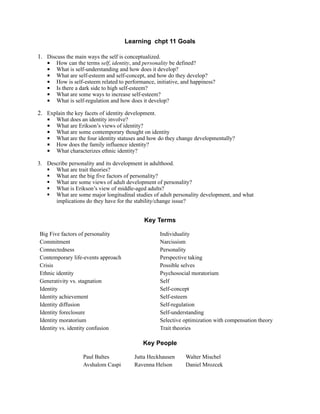
Santrock.dev psych.chpt 11.key terms
- 1. Learning chpt 11 Goals 1. Discuss the main ways the self is conceptualized. How can the terms self, identity, and personality be defined? What is self-understanding and how does it develop? What are self-esteem and self-concept, and how do they develop? How is self-esteem related to performance, initiative, and happiness? Is there a dark side to high self-esteem? What are some ways to increase self-esteem? What is self-regulation and how does it develop? 2. Explain the key facets of identity development. What does an identity involve? What are Erikson’s views of identity? What are some contemporary thought on identity What are the four identity statuses and how do they change developmentally? How does the family influence identity? What characterizes ethnic identity? 3. Describe personality and its development in adulthood. What are trait theories? What are the big five factors of personality? What are some views of adult development of personality? What is Erikson’s view of middle-aged adults? What are some major longitudinal studies of adult personality development, and what implications do they have for the stability/change issue? Key Terms Big Five factors of personality Individuality Commitment Narcissism Connectedness Personality Contemporary life-events approach Perspective taking Crisis Possible selves Ethnic identity Psychosocial moratorium Generativity vs. stagnation Self Identity Self-concept Identity achievement Self-esteem Identity diffusion Self-regulation Identity foreclosure Self-understanding Identity moratorium Selective optimization with compensation theory Identity vs. identity confusion Trait theories Key People Paul Baltes Jutta Heckhausen Walter Mischel Avshalom Caspi Ravenna Helson Daniel Mrozcek
- 2. John Clausen Claire Kopp Brent Roberts Paul Costa Daniel Levinson Robert Selman William Damon John Marcia George Vaillant Erik Erikson Hazel Markus Alan Waterman Susan Harter Robert McCrae